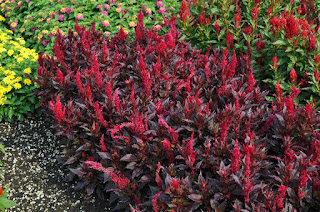Posted by: Jim Klett, Professor, Department of Horticulture and L.A., Colorado State University
The following are some of our “Best Of” winners from the
2018 trials. The complete list with
photos can be found on our website flowertrials.colostate.edu.
Best of Show – Salvia ‘Big Blue’ from PanAmerican
Seed
A later bloomer that is worth the wait was impressive
with large flower spikes that are showy in the garden as well as making a good
cut flower. Plants had dark green
foliage, strong upright growth habit, excellent branching and very uniform
overall. A strong favorite with bees as
well as humans.
Best Novelty - Artemisia ‘MAKANA™ Silver’
from TerraNova
This fine textured foliage
plant makes a great complement to many other plants in a classic border. The beautiful silver foliage is dense on vigorous
and very compact and uniform plants. It would look great in both a container as
well as ground. It makes a good filler
plant as well adding a strong textural element to any garden.
Best New Variety – Rudbeckia ‘Rising
Sun® AS Chestnut Gold’ from Green Fuse Botanicals
Huge flowers covered this plant
all season creating impressive flower power.
Besides the prolific flowering, the intense coloring of the flowers make
this a definite “55 MPH plant”. It is
impossible not to be impressed even from a brief glance at a great
distance.
Begonia semperflorens (Shade) - 'Megawatt™
Pink Bronze Leaf’ from PanAmerican Seed
The vigorous plants were
characterized by their large leaves, strong stems and large flowers. The bright pink flowers were very floriferous
and had excellent contrast with the dark foliage. Blooms were self-cleaning so the plants
always looked fresh.
Celosia – ‘Kelos® Fire Scarlet’ from Beekenkamp
The attractive dark foliage was
impressive all by itself but the abundant petite flowers were bright and made a
great contrast with the foliage. Plants
are vigorous and have good garden performance.
Coleus – ‘FlameThrower™ Serrano’ from Ball
FloraPlant
The attractive dark red foliage
had a bright green edge that created a lot of contrast and a bold look. Leaf shape was also unique and added
interest. Plants did not flower and kept
a very uniform appearance all season.
Combination – ‘Kwik Kombos™ Fire and
Ice™ Mix’ from Syngenta
Plants created a ball of
flowers in a container that had a very high “Wow!” factor. Colors were vibrant and made an excellent
mix. It was noted that very few combos
work with different genera but this is the exception as the bidens, petunia and
lobelia were equally represented and none dominated the other.
Dahlia – ‘Temptation Orange’ from Dümmen
Orange
The intense dark foliage makes
the color of the clear orange flowers really pop out. The contrast was especially good in full sun
and flower color doesn’t fade. Dark
foliage also hides dead heads and requires less maintenance. Growth habit was very uniform.
Geranium (Zonal) – ‘Brocade Cherry Night’
from Dümmen Orange
Plants were unique with foliage
that has a very large zonation with a rich chocolate color. The dark foliage makes for high contrast with
the bright rose-colored flowers. The
tight double flowers have a bit of a multiflora look to them. Overall the plants were very uniform.
.
New Guinea Impatiens – ‘Sun Harmony™
Blushing Orchid’ from Danzinger
Plants were both vigorous and
very floriferous and made a very colorful container. The large flowers held up to the sun and had
added interest due to the light lavender striping in the petals. Growth habit was very uniform.
Osteospermum ‘Osticade™ Lemon’ from Danziger
Abundant clear yellow flowers
were unusually large and had a deep yellow eye for added interest. Blooms were consistent all season long and
very showy with uniform plants with clean foliage.
Petunia (Spreading) – ‘Supertunia Vista®
Bubblegum’ from Proven Winners
This is a multi-year winner
from many past trials and is considered to be possibly the best petunia in the
last 10 years. It always has a
dependable show of prolific pink flowers with exceptional vigor.
Verbena – ‘Lanai® Upright Twister
Watercolor’ from Syngenta
Abundant flowering covered the
canopy almost all season with attractive shades of soft lavender that was
attractive even as the blooms faded.
Plants had a long lasting flower display and seemed to “bury its dead”
blooms under new ones. Uniform growth
habit and lack of any sign of mildew also made this plant a winner.
Vinca – ‘Tattoo™ Papaya’ from PanAmerican
Seed
Very unique flower color and
abundant blooms were very impressive.
Flowers had a very unusual and beautiful “inky” blush pattern that
helped earn the first part of the name, “Tattoo”. Plants had an upright growth habit and can
grow well in full sun or part shade.














































